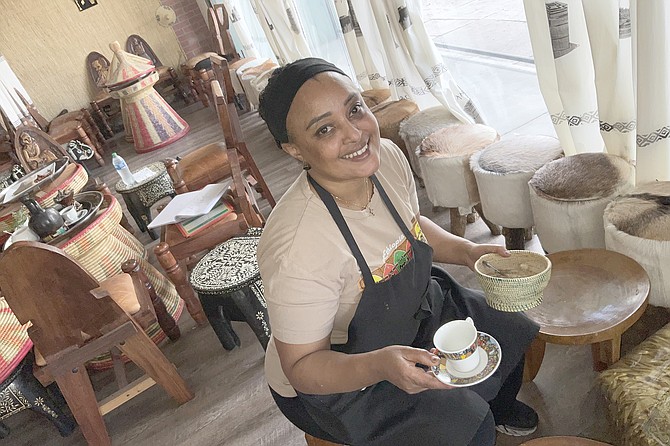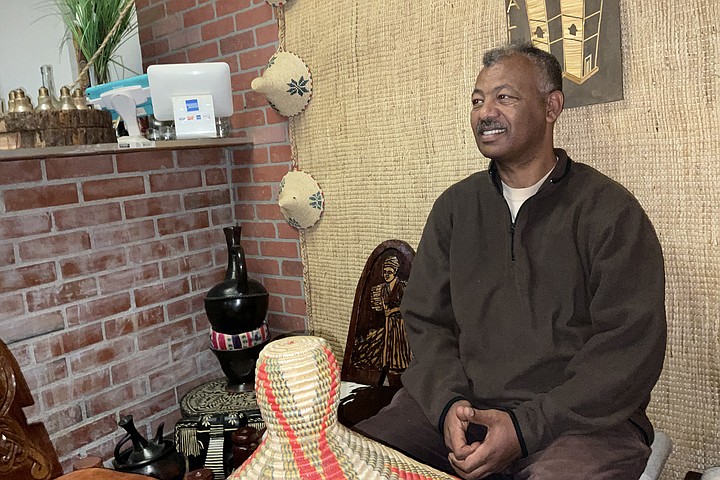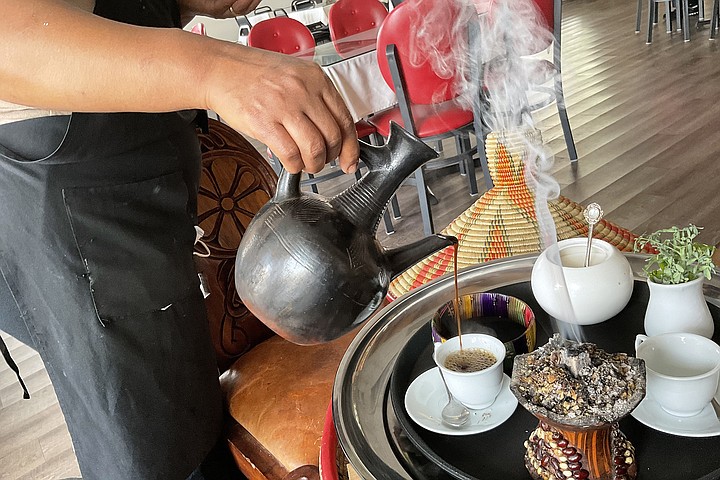 Facebook
Facebook
 X
X
 Instagram
Instagram
 TikTok
TikTok
 Youtube
Youtube

Oh yes. THIS is how to start your day. Fire-roasted Arabica coffee beans sending their smoky aroma up my nostrils, right beside a blue pylon of incense smoke. We’re talking coffee beans that have come all the way from Ethiopia, where coffee was born. And Alemtsehay is making it for me exactly the way they made it there a thousand years ago. She’s roasting raw coffee beans in a little frypan on the fire’s hot ashes, then crushing them by mortar and pestle, then pouring hot water over them, then mixing it back and forth three times until the coffee is frothing.

Now Alemtsehay lifts up the coffee pot. She lets the black stuff snake out of the Aladdin’s lamp-style spout, into my little white coffee cup. Now she grasps at a cilantro-like plant. Pulls off a couple of sprigs, and drops them into the coffee. “It’s Na-ata,” she says, “a kind of rutabaga, turnip. A mouth-cleansing herb. We add it to our coffee.”
“How did you guys, like, invent coffee?” I ask. She says it happened when Kaldi, a goat herder in Ethiopia’s Kaffa region, noticed his goats jumping around. They had been nibbling on the red berries of a bush, and now they were full of energy, even for goats. Kaldi took a nibble himself. Energy surged. He showed it to monks in a nearby monastery. They put the cherry pits in a pan on a fire. The smoking beans gave off this incredible aroma. The monks crushed them, poured boiling water over, and voilà! Coffee was born.
“Something to eat?” says Alemtsehay. I’ve learned it’s customary to have three cups of coffee minimum if you’re a guest. So it’s a latte morning: why not a little brekky too? She shows me the menu. “Take Number One,” she says. “Best. Most popular breakfast among Ethiopians.” The #1 is Kuanta Firfir, $9.99. “Marinated dried beef sautéed in berbere sauce.” I ask what berbere sauce is. “Chile peppers, she says, “coriander (cilantro), garlic, ginger, Ethiopian holy basil seeds, rue, radhuni, nigella, fenugreek…” They say the main taste that comes from this complex mix is a kinda spicy BBQ, with Southwestern hints, and curry flavors. And that’s exactly what I get from my Kuanta Firfir breakfast, with its cut-up, sautéed beef tucked into a folded flap of the Ethiopian fermented bread, injera. Oh, and did I mention heat? Not sure if you’re supposed to, but I love mixing its tastes with the rich, winey coffee.

Talking of winey, I suddenly remember Ethiopians make honey wine. And yes! They have it here ($6.99 and up). I ask Alem about it. “This time of day?” she says. “You don’t want it now. It’s too strong. You will fall asleep.” Huh. This lady cares about her customers. So next day, I’m with my friend Diana near this self-same place. We’re looking to celebrate her upcoming birthday. This is Saturday evening.
“Let’s celebrate Ethiopian-style,” I say.
“Yes, but don’t they have — what’s that soggy bread called — injera? Fermented. Not sure I’m ready to celebrate with soggy bread.”
But, hey, here we are, and it is around six. “Well,” I say. “Why not just celebrate with honey wine, or an Ethiopian beer?”
So now we’re inside. It’s half-modern and half-traditional. Natch, we go to the traditional side, because it’s so much more interesting: colorful tables made of reeds and goat- or deer-pelt-covered stools and Ethiopian chairs with, like, stories carved into their backs. (One’s a lady spinning thread, another’s an old man leaning on his stick, another’s a father reading from a book to his child, a fourth is a lady pouring coffee from a pot just like the one I saw yesterday.)
A gentleman named Fekadu comes up with menus. First, we get a beer. An Ethiopian beer. “St. George.” Costs $3.99. “This brewery is 100 years old this year,” says Fekadu. Turns out St. George is the patron saint of Ethiopia, which is a majority Christian country. But now we’ve got to eat.
“Dero wot I know,” says Diana. She’s a lady who has traveled, a lot. “Your national dish?”

“It is very popular,” says Fekadu. “It is chicken stew simmered in berbere sauce. They used to say a girl will never find a husband if she cannot cook dero wot.” I see it costs $15.99. Dero means “chicken,” and wot means “stew” in Amharic, the main language of Ethiopia. “We have a lot of wots,” says Fekadu. “Yebeg wot ($14.99) is lamb stew, Yeshiro wot ($11.99) is chickpea stew, Geba wota ($14.99) is beef.”
“No fish?” I say.
“Ethiopia is completely land-locked,” says Diana. “No coast. Seafood ain’t in their diets.” They also have a bunch of dishes that end with tibs. Basically the same meats and veggies as the wots, (and the same prices), but dry, not soaked in sauces like berbere.
Because this is a kind of celebration, we kind of blow any budget and get a selection of different dishes on a big round plate with the piles of meat and veggies separated by injera rolls.
“You could’ve done this much cheaper,” Diana says. “You’ll be taking most of this home.”
But it’s all delicious, and with the St. George and Harar beers oiling the works, a lot of fun. We’re out about $70, but it’s oh-so worth it. The one thing I notice on the menu, late, is that if you’re in tap city — strapped — you can always go the sanbusa route (think samosa in Indian places). The not-so-little pita bread triangles, stuffed with lentils or meat, go for only $1.99 each.
“Did you notice?” asks Diana? “No knives or forks.”
“Yes,” I reply, “and that’s because you have to hand-wrap everything in your favorite bread, injera. Now do you like it any more?”
“Do I have a choice?”


Oh yes. THIS is how to start your day. Fire-roasted Arabica coffee beans sending their smoky aroma up my nostrils, right beside a blue pylon of incense smoke. We’re talking coffee beans that have come all the way from Ethiopia, where coffee was born. And Alemtsehay is making it for me exactly the way they made it there a thousand years ago. She’s roasting raw coffee beans in a little frypan on the fire’s hot ashes, then crushing them by mortar and pestle, then pouring hot water over them, then mixing it back and forth three times until the coffee is frothing.

Now Alemtsehay lifts up the coffee pot. She lets the black stuff snake out of the Aladdin’s lamp-style spout, into my little white coffee cup. Now she grasps at a cilantro-like plant. Pulls off a couple of sprigs, and drops them into the coffee. “It’s Na-ata,” she says, “a kind of rutabaga, turnip. A mouth-cleansing herb. We add it to our coffee.”
“How did you guys, like, invent coffee?” I ask. She says it happened when Kaldi, a goat herder in Ethiopia’s Kaffa region, noticed his goats jumping around. They had been nibbling on the red berries of a bush, and now they were full of energy, even for goats. Kaldi took a nibble himself. Energy surged. He showed it to monks in a nearby monastery. They put the cherry pits in a pan on a fire. The smoking beans gave off this incredible aroma. The monks crushed them, poured boiling water over, and voilà! Coffee was born.
“Something to eat?” says Alemtsehay. I’ve learned it’s customary to have three cups of coffee minimum if you’re a guest. So it’s a latte morning: why not a little brekky too? She shows me the menu. “Take Number One,” she says. “Best. Most popular breakfast among Ethiopians.” The #1 is Kuanta Firfir, $9.99. “Marinated dried beef sautéed in berbere sauce.” I ask what berbere sauce is. “Chile peppers, she says, “coriander (cilantro), garlic, ginger, Ethiopian holy basil seeds, rue, radhuni, nigella, fenugreek…” They say the main taste that comes from this complex mix is a kinda spicy BBQ, with Southwestern hints, and curry flavors. And that’s exactly what I get from my Kuanta Firfir breakfast, with its cut-up, sautéed beef tucked into a folded flap of the Ethiopian fermented bread, injera. Oh, and did I mention heat? Not sure if you’re supposed to, but I love mixing its tastes with the rich, winey coffee.

Talking of winey, I suddenly remember Ethiopians make honey wine. And yes! They have it here ($6.99 and up). I ask Alem about it. “This time of day?” she says. “You don’t want it now. It’s too strong. You will fall asleep.” Huh. This lady cares about her customers. So next day, I’m with my friend Diana near this self-same place. We’re looking to celebrate her upcoming birthday. This is Saturday evening.
“Let’s celebrate Ethiopian-style,” I say.
“Yes, but don’t they have — what’s that soggy bread called — injera? Fermented. Not sure I’m ready to celebrate with soggy bread.”
But, hey, here we are, and it is around six. “Well,” I say. “Why not just celebrate with honey wine, or an Ethiopian beer?”
So now we’re inside. It’s half-modern and half-traditional. Natch, we go to the traditional side, because it’s so much more interesting: colorful tables made of reeds and goat- or deer-pelt-covered stools and Ethiopian chairs with, like, stories carved into their backs. (One’s a lady spinning thread, another’s an old man leaning on his stick, another’s a father reading from a book to his child, a fourth is a lady pouring coffee from a pot just like the one I saw yesterday.)
A gentleman named Fekadu comes up with menus. First, we get a beer. An Ethiopian beer. “St. George.” Costs $3.99. “This brewery is 100 years old this year,” says Fekadu. Turns out St. George is the patron saint of Ethiopia, which is a majority Christian country. But now we’ve got to eat.
“Dero wot I know,” says Diana. She’s a lady who has traveled, a lot. “Your national dish?”

“It is very popular,” says Fekadu. “It is chicken stew simmered in berbere sauce. They used to say a girl will never find a husband if she cannot cook dero wot.” I see it costs $15.99. Dero means “chicken,” and wot means “stew” in Amharic, the main language of Ethiopia. “We have a lot of wots,” says Fekadu. “Yebeg wot ($14.99) is lamb stew, Yeshiro wot ($11.99) is chickpea stew, Geba wota ($14.99) is beef.”
“No fish?” I say.
“Ethiopia is completely land-locked,” says Diana. “No coast. Seafood ain’t in their diets.” They also have a bunch of dishes that end with tibs. Basically the same meats and veggies as the wots, (and the same prices), but dry, not soaked in sauces like berbere.
Because this is a kind of celebration, we kind of blow any budget and get a selection of different dishes on a big round plate with the piles of meat and veggies separated by injera rolls.
“You could’ve done this much cheaper,” Diana says. “You’ll be taking most of this home.”
But it’s all delicious, and with the St. George and Harar beers oiling the works, a lot of fun. We’re out about $70, but it’s oh-so worth it. The one thing I notice on the menu, late, is that if you’re in tap city — strapped — you can always go the sanbusa route (think samosa in Indian places). The not-so-little pita bread triangles, stuffed with lentils or meat, go for only $1.99 each.
“Did you notice?” asks Diana? “No knives or forks.”
“Yes,” I reply, “and that’s because you have to hand-wrap everything in your favorite bread, injera. Now do you like it any more?”
“Do I have a choice?”